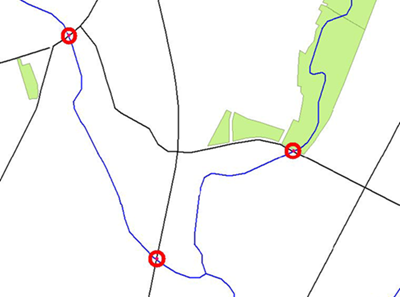Content Transformation
Content transformations are those that operate on the components of a feature.
What is a Feature?
A feature in FME is an individual item within the translation. For spatial data, a feature is generally a geometric object (with or without a set of related attributes).
For tabular data, a feature is generally a record in a database, a row in a spreadsheet, or a line in a text file. Each column or cell is known as an attribute.
Features in FME have a flexible, generic representation that is unrelated to the format from which they originated. That means any transformer can operate on any FME feature, regardless of its source format. Sometimes content transformation operates on single features, sometimes on multiple features at once.
| FME Lizard says... |
|
You can think of Content Transformation as altering or editing data.
The wardrobe analogy still works here. You might take your clothes from the wardrobe to clean them, or alter them, or repair them, or dye them a new color, or all sorts of other tasks, before returning them to their place. The same holds true for spatial data transformation: it's the act of fixing up your data to be cleaner and in the style you really want. |
Geometric Transformation
Geometric Transformation is the act of restructuring the spatial component of an FME feature. In other words, the geometry of the feature undergoes some form of change to produce a different output.
Some examples of geometric transformation include the following:
- Generalization – a cartographic process that restructures data so it's easily visualized at a given map scale
- Warping – adjustment of the size and shape of a set of features to more closely match a set of reference data
- Topology Computation – conversion of a set of linear features into a node/line structure
- Line Intersection - calculation of the intersection points between line features
Here roads have been intersected with rivers to produce points that mark the location of bridges.
Attribute Transformation
Attribute Transformation is the act of restructuring the tabular components of an FME feature. In other words, the attributes undergo some form of change to produce a different output.
Some examples of attribute transformation are:
- Concatenation – joining together of two or more attributes
- Splitting – splitting one attribute into many, which is the opposite of Concatenation
- Measurement – measuring a feature's length or area to create a new attribute
- ID Creation – creating a unique ID number for a particular feature
In this example of attribute concatenation, each line of the address is concatenated to return a single line address.
Address1 Suite 1200,+ Address2 9639-137a Street,+ City Surrey,+ Province British Columbia,+ PostalCode V3T 0M1 = Address Suite 1200, 9639-137a Street, Surrey, British Columbia, V3T 0M1

